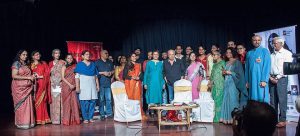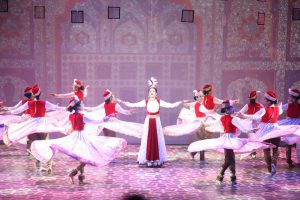Bhoomija meaning ‘born of the earth’ is a Bengaluru based Performing Arts trust that was started in Aug 2012 with a clear mandate of making the finest performing arts accessible to all audiences. It is the brainchild of Gayathri Krishna and is a trust that includes Anjali Joshi and Archana Prasad. In a span of 5 years, Bhoomija has become a well-known name in Bengaluru and has exceeded expectations in its mission of showcasing the rich heritage and variety of performing arts from around the world in India, and taking Indian music and dance to world venues and festivals. They have done close to 125 shows with maestros like Padma Vibhushana Umayalpuram K Sivaraman, Padma Bhushana Vikku Vinayakram, Padma Bhushana Prabha Atre, Bombay Jayashri, TM Krishna, Roysten Abel, Aruna Sairam, Malavika Sarukkai, Ranjani-Gayatri, Abhishek Raghuram etc.
I caught up with Gayathri recently and she passionately spoke about, what she calls her daughter, Bhoomija. Here are some snippets of our conversation.
Swapna: I have seen you in corporate meeting rooms, then in the corridors of Ranga Shankara as Arundhati Nag’s able right hand, and now as the torch bearer of Bhoomija. You seem to have come a long way. What drove you to walk this unique, and largely unheard of path?
Gayathri: Well, it is a journey that began long back. I have always an attentive and appreciative audience. Right from a young age, I used to go and attend all possible plays and theatre shows that happened in Bengaluru. My career at that time was largely based outside India. But whenever I was in in India, I ensured I caught up on plays. And, I have this habit to go back stage after the play and appreciate the performers.
This was the time when the play Nagamandala was staged by Arundhati Nag and Shankar Nag and as always, I went up backstage and met them too.
A few years later, after Shankar Nag had passed away, I read an article by Sowmya Aji which said Arundhati Nag’s dream is crying for funds. Excited that such an initiative had been thought of for the cultural scene of my city, and appalled that the dream may not materialize because of lack of funds, I immediately reached out to Arundhati, made a little contribution and requested her to make me a part of the team. To give credit to her, she remembered me from those backstage interactions. Though my contribution was quite small to her overall vision, it was well appreciated by her. And that began my journey with Ranga Shankara.
Things eventually changed at my end and I moved back to Bengaluru for good and got further involved with Ranga Shankara. Today Ranga Shankara is the one of the leading theatres in India hosting both national and international plays of repute.
Bhoomija, on the other hand, focusses on the performing arts space. It all began with one of the children shows that we had curated at Ranga Shankara. The show was over and I had just stepped out in the lobby where I saw a few young children exclaiming in joy while interacting with artists. Those children never knew about the concept of live shows and were mesmerized by the artists and were touching and feeling them to make sure they were for real! That was my moment of truth. It dawned on me that, if let go, the roots will get uprooted and we will completely lose touch with the performing arts heritage of our country!
So, that sowed the seeds for coming up with a platform that makes the finest performing arts accessible to all audiences, remunerative for artistes and sustainable for the organizers. And Bhoomija was born to showcase the rich heritage and variety of performing arts from around the world in India, and taking Indian music and dance to world venues and festivals.
And today, I am so glad to share that we have done close to 125+ shows in a span of 5 years and all of them were very well received and appreciated.
Swapna: Apart from the diminishing focus on our culture, the passion for performing arts also seems to be the core driver for you. So where were those seeds sown? How was your childhood? Was it spent entirely in the lap of art, music, and theatre?
Gayathri: Well, yes. I hail from a family of musicians. My father, Vidwaan HN Krishna, was a musician who used to regularly perform. He would be someone who would be constantly singing and hence music ran in our lives. My home used to constantly resonate with discussions on swara, tala, shruti, raga, kriti etc. and thus music became an intrinsic part of my life. While I did not take to music as a profession, I did become a discerning listener.
Swapna: Performing arts is fairly well defined in our country, especially in the south of India. Yet Bhoomija, since its inception has made a mark. Your first show with Bombay Jayashri was a super hit. Subsequently you have done many shows. What differentiates Bhoomija?
Gayathri: My vision is to bring the best to the masses. I want best of the artists to perform for the widest of the masses, so that the art form seeps in and gets entrenched into our society and does not run the risk of uprooting! Our culture must sustain for generations to come.
That said, I also want people to listen/see, what I call in common terms – superstar artists – at an affordable price. All our shows were priced at Rs.300 per seat. While I am constantly advised that I should increase the ticket price for stalwarts who perform for Bhoomija, I do not believe in that. I cannot deny the sustenance pressures, but for them I work harder. And with now GST in play, we have further reduced our ticket price to Rs.249, but that is fine.
Another differentiator is that contrary to the normal shows, our shows always have a narration by the artist. This narrative ensures the show is holistic and the audience is involved and connected. We have experimented with unique formats that have worked very well. For example, a show titled – Different Tongues, One Heart Beat – was done by Ranjani Gayatri that had songs from 13 different languages. And the show was well received and highly appreciated. Artists like to perform for a receptive audience, and we want the audiences to experience the lyrics, story, melody, music or visuals all in a format that appeals and connects.
And finally, all the costumes used in our show are stitched in Khadi. I strongly insist on using khadi and organic textiles. Going back to the roots, back to where we all come from, back to our earth.
Swapna: Children, and motivating them to take up performing arts, seem to be another critical core in your vision for Bhoomija. Motivating children to take up classical music/art forms has never been an easy task. More so in today’s times, where gadgets take more precedence and western forms of music are more influential. At times like these, you managed to set up initiatives like JackFruit, Manganiyar, Carnatic Choir, Youth Carnatic Orchestra etc. curated by stalwarts like Jayanti Kumaresh, Bombay Jayashri, Vikku Vinayaka Ram etc. Tell us something more about it.
Gayathri: Children are my core motivators. They are the key to continue with our traditional art forms and it is our responsibility to make them aware, appreciate, experience these and eventually engrain it within their own core beings. Jackruit series, Manganiyar Class Room, Youth Orchestra are all group initiatives where artists put up a show with the children.
So now we have a largely solo pursuit, now transformed into an ensemble that is enabling the students to get a different feel of the art form. Students are generally attached very closely to their gurus, and they rarely get a chance to perform with other gurus.
 Our idea is to see if we can, while the musicians are young enough to be able to, get together for an ensemble show, with a maestro who is willing to work with them. Also, we give these productions a theatre director who brings in the aesthetic and fun elements, to make the concert into a proper show.
Our idea is to see if we can, while the musicians are young enough to be able to, get together for an ensemble show, with a maestro who is willing to work with them. Also, we give these productions a theatre director who brings in the aesthetic and fun elements, to make the concert into a proper show.
And it also has a few more significant advantages – a) Artists are enthusiastic about a format like this. They are game and they love this format of imparting and sharing. b) We are able to identify the child prodigies. Quite a few of these kids have found pedestals to further grow. c) The children get a taste of the art form presented differently that their own guru. They also get to interact with other students of classical music, make new friends, have fun and collectively learn. Their music awareness goes beyond what they knew all the while and opens the world for them. d) Last, but not the least, the sheer joy of seeing these children perform is immeasurable.
Not to forget the fun that, I and the artists, have in teaching them, making them rehearse, planning their costumes, keeping them interested and eventually seeing them perform. Each of our performances have been highly successful and has left an impact.
Swapna: Bhoomija has just completed 5 years. We have seen a diverse set of musicians, performances, and collaborations on stage and each one of them have been successful, wonderful and most importantly mesmerizing. And our Bengaluru audience seems to be lapping it all up! Whether it is individual performances by superstar artists or collaborative shows like SamMohanam, Rajasthani Folk by Roysten Abel, or the recent Karnataka Sufi songs Manteswamy Kavya, each of them seems to be hand-picked and curated with a purpose. What is the purpose, or in corporate terms – the strategy, behind it?
Gayathri: Couple of things that have driven us at Bhoomija so far – senior artists, well thought out performances, unique themes, and wonderful collaborations. And audiences enjoy these collaborations that are deep rooted yet differently presented.
And let me also tell you, artists love to collaborate. They love to interact with other artists and work together to create beautiful pieces that not only bring out the best of both the art forms but also give an enthralling experience for the audience. Very similar to the Crème da le Crème or Hot Chocolate Fudge ice cream. While Vanilla is the core, you enjoy the add-ons to feel sheer bliss.
Each of these shows that you talk about, whether it is SamMohanam, Shabad Dhun Lagi, Rajasthani Manganiyar or Manteswamy Kavya –are all either unique collaborations or delightful rooted flavors of our country and people must listen, enjoy and revel in their beauty.
Swapna: Going global is always the mantra for all things Indian. You opened the world for Bhoomija and took it to Syndey, U.S. and even China. What have been your experiences there? Have you been able to paint an Indian narrative that is based on our rich culture and heritage to the world? And what next in the global arena?
Gayathri: We wanted to take Indian classical music to world music centres. So, the concerts in the main venues of Sydney Opera House and Carnegie Hall. The diaspora enjoyed these experiences immensely.
But what still holds us in awe at Bhoomija is our China experience. Bombay Jayashri was just nominated for the Academy Awards and we tied up with a festival presenter in China for a six-city tour concert tour with workshops. We ended up with 4 workshops with each workshop having about 300 participants. It is a significant feat that so many people wanted to learn the nuances of Indian Classical Music and were willing to invest that kind of time to get oriented to it. I find something like this so beautiful and touching – the fact that people are keen and lap up an opportunity that comes their way to learn about something so alien to them. And the power our music must enable something like this.
Now, we are on a mission of bringing the best of the world to Bengaluru. We are planning to build a performing arts centre that will bring together some great talent from around the world in its design and execution. Hopefully, we will be able to pull this together soon. The centre will be named after MS Subbulakshmi, as our tribute to the best known trailblazing performers of India. So, till then, enjoy our shows, and motivate Bhoomija to work towards its two-faced purpose of reconnecting with our roots, and building a world class theatre here.
Swapna Narayanan is an author of short stories and poems currently based in Bengaluru, India.

 y last year that was inaugurated by Shyam Benegal, and it was a huge success. It managed to enliven back Smita Patil into our lives and showcased her as a classic actress to the newer generation who had only heard about her. What made the festival different though was the conversations that made people reflect and think deeper, and of course left a lingering taste and memory long after it was over, much to their liking!
y last year that was inaugurated by Shyam Benegal, and it was a huge success. It managed to enliven back Smita Patil into our lives and showcased her as a classic actress to the newer generation who had only heard about her. What made the festival different though was the conversations that made people reflect and think deeper, and of course left a lingering taste and memory long after it was over, much to their liking!

 Our idea is to see if we can, while the musicians are young enough to be able to, get together for an ensemble show, with a maestro who is willing to work with them. Also, we give these productions a theatre director who brings in the aesthetic and fun elements, to make the concert into a proper show.
Our idea is to see if we can, while the musicians are young enough to be able to, get together for an ensemble show, with a maestro who is willing to work with them. Also, we give these productions a theatre director who brings in the aesthetic and fun elements, to make the concert into a proper show.


